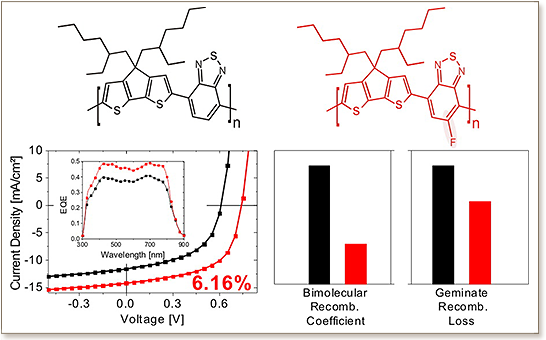 A novel fluorinated copolymer (F-PCPDTBT) is introduced and shown to exhibit significantly higher power conversion efficiency in bulk heterojunction solar cells with PC 70BM compared to the well-known low-band-gap polymer PCPDTBT. Fluorination lowers the polymer HOMO level, resulting in high open-circuit voltages well exceeding 0.7 V. Optical spectroscopy and morphological studies with energy-resolved transmission electron microscopy reveal that the fluorinated polymer aggregates more strongly in pristine and blended layers, with a smaller amount of additives needed to achieve optimum device performance. Time-delayed collection field and charge extraction by linearly increasing voltage are used to gain insight into the effect of fluorination on the field dependence of free charge-carrier generation and recombination. F-PCPDTBT is shown to exhibit a significantly weaker field dependence of free charge-carrier generation combined with an overall larger amount of free charges, meaning that geminate recombination is greatly reduced. Additionally, a 3-fold reduction in non-geminate recombination is measured compared to optimized PCPDTBT blends. As a consequence of reduced non-geminate recombination, the performance of optimized blends of fluorinated PCPDTBT with PC 70BM is largely determined by the field dependence of free-carrier generation, and this field dependence is considerably weaker compared to that of blends comprising the non-fluorinated polymer. For these optimized blends, a short-circuit current of 14 mA/cm 2, an open-circuit voltage of 0.74 V, and a fill factor of 58% are achieved, giving a highest energy conversion efficiency of 6.16%. The superior device performance and the low band-gap render this new polymer highly promising for the construction of efficient polymer-based tandem solar cells.
A novel fluorinated copolymer (F-PCPDTBT) is introduced and shown to exhibit significantly higher power conversion efficiency in bulk heterojunction solar cells with PC 70BM compared to the well-known low-band-gap polymer PCPDTBT. Fluorination lowers the polymer HOMO level, resulting in high open-circuit voltages well exceeding 0.7 V. Optical spectroscopy and morphological studies with energy-resolved transmission electron microscopy reveal that the fluorinated polymer aggregates more strongly in pristine and blended layers, with a smaller amount of additives needed to achieve optimum device performance. Time-delayed collection field and charge extraction by linearly increasing voltage are used to gain insight into the effect of fluorination on the field dependence of free charge-carrier generation and recombination. F-PCPDTBT is shown to exhibit a significantly weaker field dependence of free charge-carrier generation combined with an overall larger amount of free charges, meaning that geminate recombination is greatly reduced. Additionally, a 3-fold reduction in non-geminate recombination is measured compared to optimized PCPDTBT blends. As a consequence of reduced non-geminate recombination, the performance of optimized blends of fluorinated PCPDTBT with PC 70BM is largely determined by the field dependence of free-carrier generation, and this field dependence is considerably weaker compared to that of blends comprising the non-fluorinated polymer. For these optimized blends, a short-circuit current of 14 mA/cm 2, an open-circuit voltage of 0.74 V, and a fill factor of 58% are achieved, giving a highest energy conversion efficiency of 6.16%. The superior device performance and the low band-gap render this new polymer highly promising for the construction of efficient polymer-based tandem solar cells.